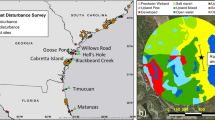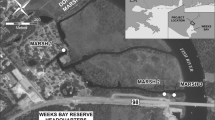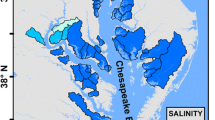Abstract
Multiple disturbances to ecosystems can influence community structure by modifying resistance to and recovery from invasion by non-native species. Predicting how invasibility responds to multiple anthropogenic impacts is particularly challenging due to the variety of potential stressors and complex responses. Using manipulative field experiments, we examined the relative impact of perturbations that primarily change abiotic or biotic factors to promote invasion in coastal salt marsh plant communities. Specifically we test the hypotheses that nitrogen enrichment and human trampling facilitate invasion of upland weeds into salt marsh, and that the ability of salt marsh communities to resist and/or recover from invasion is modified by hydrological conditions. Nitrogen enrichment affected invasion of non-native upland plants at only one of six sites, and increased aboveground native marsh biomass at only two sites. Percent cover of native marsh plants declined with trampling at all sites, but recovered earlier at tidally flushed sites than at tidally restricted sites. Synergistic interactions between trampling and restricting tidal flow resulted in significantly higher cover of non-native upland plants in trampled plots at tidally restricted sites. Percent cover of non-native plants recovered to pre-trampling levels in fully tidal sites, but remained higher in tidally restricted sites after 22 months. Thus, perturbations that reduce biotic resistance interact with perturbations that alter abiotic conditions to promote invasion. This suggests that to effectively conserve or restore native biodiversity in altered systems, one must consider impacts of multiple human disturbances, and the interactions between them.





Similar content being viewed by others
References
Allison SK (1995) Recovery from small-scale anthropogenic disturbances by northern California salt marsh plant assemblages. Ecol Appl 1995:693–702
Bertness MD, Callaway RM (1994) Positive interactions in communities. Trends Ecol Evol 9:191–193
Bertness MD, Ewanchuk PJ, Silliman BR (2002) Anthropogenic modification of New England salt marsh landscapes. Proc Natl Aca Sci USA 99:1395–1398
Boyer KE, Fong P, Vance RR, Ambrose RF (2001) Salicornia virginica in a southern California salt marsh: seasonal patterns and a nutrient-enrichment experiment. Wetlands 21:315–326
Boyer KE, Zedler JB (1998) Effects of nitrogen additions on the vertical structure of a constructed cordgrass marsh. Ecol Appl 8:692–705
Boyer KE, Zedler JB (1999) Nitrogen addition could shift plant community composition in a restored California salt marsh. Res Ecol 7:74–85
Browning BM (1972) The natural resources of Elkhorn Slough: their present and future use. In: Coastal Wetland Series no. 4. California Department of Fish and Game, Sacramento
Bruno J, Stachowicz JJ, Bertness MD (2003) Inclusion of facilitation into ecological theory. Trends Ecol Evol 18:119–125
Caffrey JM, Brown M, Tyler WB, Silberstein M (2002) Changes in a California estuary: a profile of Elkhorn Slough. Elkhorn Slough Foundation, Moss Landing, CA
Christensen NL et al (1996) The report of the Ecological Society of America committee on the scientific basis for ecosystem management. Ecol Appl 6:665–691
Connell JH, Sousa WP (1983) On the evidence needed to judge ecological stability or persistence. Am Nat 121:789–824
Covin JD, Zedler JB (1988) Nitrogen effects on Spartina foliosa and Salicornia virginica in the salt marsh at Tijuana Estuary, California. Wetlands 8:51–65
D’Antonio CM (1993) Mechanisms controlling invasion of coastal plant communities by the alien succulent Carpobrotus edulis. Ecology 74:83–95
Davis MA, Grime JP, Thompson K (2000) Fluctuating resources in plant communities: a general theory of invasibility. J Ecol 88:528–534
Davis MA, Pelsor M (2001) Experimental support for a resource-based mechanistic model of invasibility. Ecol Lett 4:421–428
Dethier MN, Hacker SD (2005) Physical factors vs. biotic resistance in controlling the invasion of an estuarine marsh grass. Ecol Appl 15:1273–1283
Folt CL, Chen CY, Moore MV, Burnaford J (1999) Synergism and antagonism among multiple stressors. Limnol Oceanogr 44:864–877
Gibson KD, Zedler JB, Langis R (1994) Limited response of cordgrass (Spartina foliosa) to soil amendments in a constructed marsh. Ecol Appl 4:757–767
Hester AJ, Hobbs RJ (1992) Influence of fire and soil nutrients on native and non-native annuals at remnant vegetation edges in the western Australian wheatbelt. J Veg Sci 3:101–108
Hobbs RJ, Atkins L (1988) Effect of disturbance and nutrient addition on native and introduced annuals in plant communities in the Western Australian wheatbelt. Aus J Ecol 13:171–179
Hobbs RJ, Huenneke LF (1992) Disturbance, diversity, and invasion implications for conservation. Conserv Biol 6:324–337
Hughes TP, Bellwood DR, Folke C, Steneck RS, Wilson J (2005) New paradigms for supporting the resilience of marine ecosystems. Trends Ecol Evol 20:380–386
James ML, Zedler JB (2000) Dynamics of wetland and upland subshrubs at the salt marsh-coastal sage scrub ecotone. Am Midl Nat 143:298–311
Johnstone IM (1986) Plant invasion windows: a time-based classification of invasion potential. Biol Rev 61:369–394
Kercher SM, Zedler JB (2004) Multiple disturbances accelerate invasion of reed canary grass (Phalaris arundinacea L) in a mesocosm study. Oecologia 138:455–464
Kuhn NL, Zedler JB (1997) Differential effects of salinity and soil saturation on native and exotic plants of a coastal salt marsh. Estuaries 20:391–403
Lake JC, Leishman MR (2004) Invasion success of exotic plants in natural ecosystems: the role of disturbance, plant attributes and freedom from herbivores. Biol Conserv 117:215–226
Lenihan HS, Micheli F, Shelton SW, Peterson CH (1999) The influence of multiple environmental stressors on susceptibility to parasites: an experimental determination with oysters. Limnol Oceanogr 44:910–924
Lenihan HS, Peterson CH (1998) How habitat degradation through fishery disturbance enhances impacts of hypoxia on oyster reefs. Ecol Appl 8:128–140
Lindig-Cisneros R, Desmond J, Boyer KE, Zedler JB (2003) Wetland restoration thresholds: can a degradation transition be reversed with increased effort? Ecol Appl 13:193–205
Lotze HK, Worm B (2002) Complex interactions of climatic and ecological controls on macroalgal recruitment. Limnol Oceanogr 47:1734–1741
Macdonald KB (1977) Coastal salt marsh. In: Barbour MG, Major J (eds) Terrestrial vegetation in California. Wiley, New York, pp 263–294
Menge BA, Sutherland JP (1987) Community regulation: variation in disturbance, competition, and predation in relation to environmental stress and recruitment. Am Nat 130:730–757
Moyle PB, Light T (1996) Fish invasions in California: do abiotic factors determine success? Ecology 77:1666–1670
Noe GB, Zedler JB (2001) Spatio-temporal variation of salt marsh seedling establishment in relation to the abiotic and biotic environment. J Veg Sci 12:61–74
Commission Pew Oceans (2003) America’s living oceans: charting a course for sea change. Summary report. In: Pew Oceans Commission. Arlington, VA
Phillips B, Stephenson M, Jacobi M, Ichikawa G, Silberstein M, Brown M (2002) Land use and contaminants. In: Caffrey JM, Brown M, Tyler WB, Silberstein M (eds) Changes in a California estuary: a profile of Elkhorn Slough. Elkhorn Slough Foundation, Moss Landing, CA, pp 237–256
Pickett STA, White PS (1985) The ecology of natural disturbance and patch dynamics. Academic Press, Orlando
Shea K, Chesson P (2002) Community ecology theory as a framework for biological invasions. Trends Ecol Evol 17:170–176
Shumway SW, Bertness MD (1994) Patch size effects on marsh plant secondary succession mechanisms. Ecology 75:564–568
Sih A, Bell AM, Kerby JL (2004) Two stressors are far deadlier than one. Trends Ecol Evol 19:274–276
Tilman D (1997) Community invasibility, recruitment limitation, and grassland biodiversity. Ecology 78:81–92
Traut BH (2005) The role of coastal ecotones: a case study of the salt marsh/upland transition zone in California. J Ecol 93:279–290
Underwood AJ (1997) Experiments in ecology. Cambridge University Press, Cambridge
Underwood AJ, Chapman MG (2001) GMAV5 Institute of Marine Ecology, 5th edn. University of Sydney, Sydney
US Commission on Ocean Policy (2004) An Ocean Blueprint for the 21st Century. Final Report. In: U.S. Commission on Ocean Policy, Washington DC
Van Dyke E, Wasson K (2005) Historical ecology of a central California estuary: 150 years of habitat change. Estuaries 26:173–189
Vitousek PM (1990) Biological invasions and ecosystem processes: towards an integration of population biology and ecosystem studies. Oikos 57:7–13
Woolfolk AM (1999) Effects of human trampling and cattle grazing on salt marsh assemblages in Elkhorn Slough, California. Masters Thesis. Moss Landing Marine Laboratories and California State University Sacramento, Moss Landing, CA, p. 64
Zedler JB (1996) Ecological function and sustainability in created wetlands. In: Falk DA, Millar CI, Olwell M (eds) Restoring diversity: strategies for reintroduction of endangered plants. Island Press, Washington DC, pp 331–342
Zedler JB, Winfield T, Williams P (1980) Salt marsh productivity with natural and altered tidal circulation. Oecologia 44:236–240
Zimmerman RC, Caffrey J (2002) Primary producers. In: Caffrey J, Brown M, Tyler WB, Silberstein M (eds) Changes in a California estuary: a profile of Elkhorn Slough. Elkhorn Slough Foundation, Moss Landing, CA, pp 117–135
Acknowledgments
We are indebted to Kendall Madden for helping with all of the fieldwork and putting up with sun and ticks. Thanks to Andrea Woolfolk for inspiring the trampling study and for thoughtful advice. We thank Eric Van Dyke for creating Fig. 1. Thanks to Pamela Matson, Peter Jewett, Carrie Nielsen, and Scott Wankel of Stanford University for help with soil nitrogen analyses and soil sampling. Patrick Martone, Fiorenza Micheli, and Kristy Kroeker, and two anonymous reviewers helped improve the manuscript. Support for this research came from the Elkhorn Slough National Estuarine Research Reserve and Hopkins Marine Station, with funding provided by the Estuarine Reserve Division of the National Oceanic and Atmospheric Administration. All experiments were conducted in a manner that complied with laws of the United States of America.
Author information
Authors and Affiliations
Corresponding author
Additional information
Communicated by Debra Peters.
Electronic supplementary material
Below is the link to the electronic supplementary material.
Rights and permissions
About this article
Cite this article
Goldman Martone, R., Wasson, K. Impacts and interactions of multiple human perturbations in a California salt marsh. Oecologia 158, 151–163 (2008). https://doi.org/10.1007/s00442-008-1129-4
Received:
Accepted:
Published:
Issue Date:
DOI: https://doi.org/10.1007/s00442-008-1129-4




